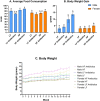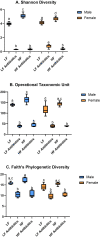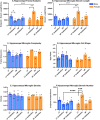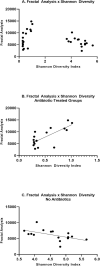Sex differences in the fecal microbiome and hippocampal glial morphology following diet and antibiotic treatment
- PMID: 35385494
- PMCID: PMC8985946
- DOI: 10.1371/journal.pone.0265850
Sex differences in the fecal microbiome and hippocampal glial morphology following diet and antibiotic treatment
Abstract
Rising obesity rates have become a major public health concern within the United States. Understanding the systemic and neural effects of obesity is crucial in designing preventive and therapeutic measures. In previous studies, administration of a high fat diet has induced significant weight gain for mouse models of obesity. Interestingly, sex differences in high-fat diet-induced weight gain have been observed, with female mice gaining significantly less weight compared to male mice on the same high-fat diet. It has also been observed that consumption of a high-fat diet can increase neurogliosis, but the mechanism by which this occurs is still not fully understood. Recent research has suggested that the gut microbiome may mediate diet-induced glial activation. The current study aimed to (1) analyze changes to the gut microbiome following consumption of a high fat (HF) diet as well as antibiotic treatment, (2) evaluate hippocampal microgliosis and astrogliosis, and (3) identify sex differences within these responses. We administered a low fat (Research Diets D12450 K) or high fat diet (Research Diets D12451) to male and female C57Bl/6 mice for sixteen weeks. Mice received an antibiotic cocktail containing 0.5g/L of vancomycin, 1.0 g/L ampicillin, 1.0 g/L neomycin, and 1.0 g/L metronidazole in their drinking water during the last six weeks of the study and were compared to control mice receiving normal drinking water throughout the study. We observed a significant reduction in gut microbiome diversity for groups that received the antibiotic cocktail, as determined by Illumina next-generation sequencing. Male mice fed the HF diet (± antibiotics) had significantly greater body weights compared to all other groups. And, female mice fed the low fat (LF) diet and administered antibiotics revealed significantly decreased microgliosis and astrogliosis in the hippocampus compared to LF-fed females without antibiotics. Interestingly, male mice fed the LF diet and administered antibiotics revealed significantly increased microgliosis, but decreased astrogliosis, compared to LF-fed males without antibiotics. The observed sex differences in LF-fed mice given antibiotics brings forward questions about sex differences in nutrient metabolism, gut microbiome composition, and response to antibiotics.
Conflict of interest statement
The authors have declared that no competing interests exist.
Figures









References
-
- Wang Y, Beydoun MA, Min J, Xue H, Kaminsky LA, Cheskin LJ. Has the prevalence of overweight, obesity and central obesity levelled off in the United States? Trends, patterns, disparities, and future projections for the obesity epidemic. Int J Epidemiol. 2020;49(3):810–23. doi: 10.1093/ije/dyz273 - DOI - PMC - PubMed
-
- Fryar CD, Gu Q, Ogden CL. Anthropometric reference data for children and adults: United States, 2007–2010. Vital Health Stat 11. 2012(252):1–48. - PubMed
-
- Hales CM, Carroll MD, Fryar CD, Ogden CL. Prevalence of Obesity and Severe Obesity Among Adults: United States, 2017–2018. NCHS Data Brief. 2020(360):1–8. - PubMed
-
- Centers for Disease Control and Prevention [CDC]. Overweight and Obesity. [Internet]. 2020. Available from: https://www.cdc.gov/obesity/data/adult.html
Publication types
MeSH terms
Substances
Associated data
Grants and funding
LinkOut - more resources
Full Text Sources
Medical
Research Materials
Miscellaneous

